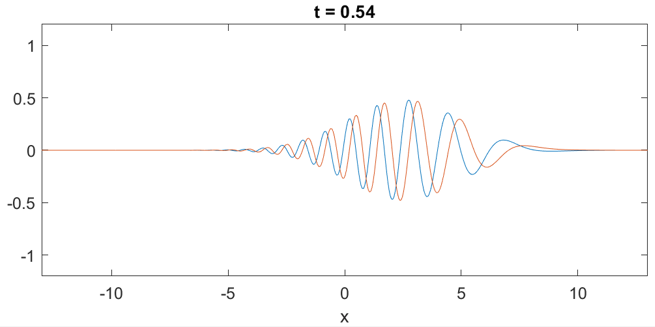简谐振子中的高斯波包模拟(Matlab)
贡献者: addis
图 1:运行结果,动画见这里。
本文使用原子单位制。令无限深势阱的束缚态为 $\psi_n(x)$,含时波函数为 $\psi(x, t)$,已知 $\psi(x, 0)$,那么由式 9 得
\begin{equation}
\psi(x, t) = \sum_{n=1}^\infty C_n\psi_n(x) \mathrm{e} ^{- \mathrm{i} E_n t}~.
\end{equation}
\begin{equation}
C_n = \int_{-\infty}^{+\infty} \psi_n(x)\psi(x, 0) \,\mathrm{d}{x} \qquad (n=0,1,\dots)~.
\end{equation}
注意经过一个周期后,波包模方的形状并不会改变,只是相位改变了。这和经典力学是相符的,根据经典的简谐振子模型,无论初始时刻质点的位置和速度是多少,一个周期后都会回到原位。
一般来说,波包扩散是因为初始时存在一定的速度分布。例如中心动量为零的波包经过较长时间 $t$ 后,位置分布就会趋近于初始动量分布乘以 $t$。
代码 1:SHOqm.m
% 高斯波包在简谐振子势阱中运动
function SHOqm
% === 参数 ===
m = 1; w = 1; % 质量,角频率
xmin = -13; xmax = 13; Nx = 500; % x 网格
tmin = 0; tmax = 2*pi/w; Nt = 200; % 时间网格
Nn = 70; % 束缚态的数量
x0 = 0; sig_x = 2; % 初始位置, 波包宽度
p0 = 5; % 初始动量
t0 = 0; % 高斯波包的初始时间
ax = [xmin, xmax, -1.2, 1.2]; % 坐标范围
% ===========
x = linspace(xmin, xmax, Nx);
psi_bound = zeros(Nn, Nx);
%% 计算并画前几个束缚态
figure;
for n = 0:Nn-1
psi_bound(n+1,:) = psi_SHO(m, w, n, x);
if n <= 4
plot(x, psi_bound(n+1,:)); hold on; grid on;
end
end
axis([-5, 5, -0.7, 0.8]);
xlabel x; title '\psi_n';
legend({'n=0','n=1','n=2','n=3','n=4'});
%% 计算高斯波包的初始展开系数
C = zeros(1, Nn);
psi_gs = @(x) 1/(2*pi*sig_x^2)^0.25/sqrt(1 + 1i*t0/(2*m*sig_x^2))...
*exp(-(x-x0-p0*t0/m).^2/(2*sig_x)^2/(1 + 1i*t0/(2*m*sig_x^2)))...
.*exp(1i*p0*(x-p0*t0/(2*m)));
plot(x, real(psi_gs(x)));
for n = 0:Nn-1
psi_sho = @(x) psi_SHO(m, w, n, x);
C(n+1) = integral(@(x) psi_sho(x).*psi_gs(x), xmin, xmax);
end
figure; plot(abs(C).^2);
%% 含时动画
figure; set(gcf, 'Unit', 'Normalized', 'Position', [0.1, 0.1, 0.4, 0.3]);
t = linspace(tmin, tmax, Nt);
for it = 1:Nt
psi = zeros(1, Nx);
for n = 0:Nn-1
En = (0.5 + n)*w;
psi = psi + C(n+1)*exp(-1i*En*t(it))*psi_bound(n+1,:);
end
clf;
plot(x, real(psi)); hold on;
plot(x, imag(psi)); axis(ax);
xlabel x; title(['t = ' num2str(t(it), '%.2f')]);
set(gca, 'FontSize', 12);
saveas(gcf, [num2str(it), '.png']);
end
end
% 简谐振子束缚态波函数
function psi = psi_SHO(m, w, n, x)
alpha = sqrt(m*w); u = alpha * x;
psi = 1/sqrt(2^n*factorial(n)) *...
(alpha^2/pi)^0.25 * hermiteH(n, u) .* exp(-u.^2/2);
end
